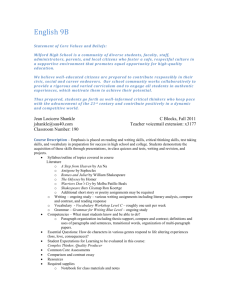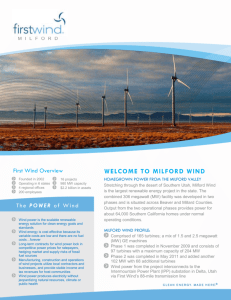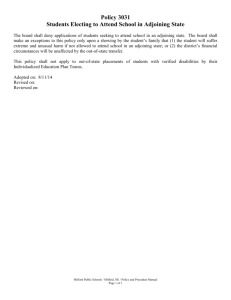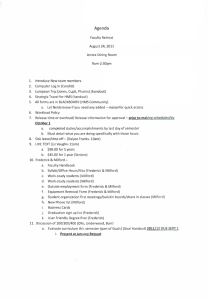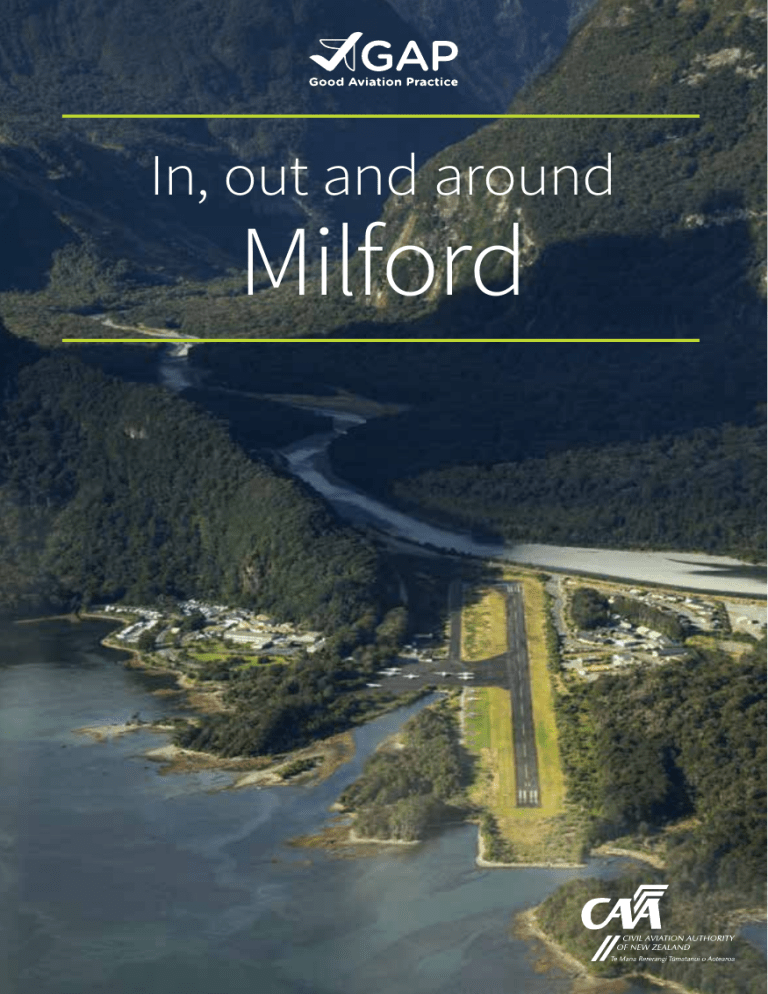
In, out and around Milford 2 Caples Valley McKellar Saddle Greenstone Valley Lake McKellar Greenstone Saddle Lake Howden Contents Introduction..........................................4 Avoid peak times.....................................4 Milford Sound weather.............................6 Don’t be deceived...........................................6 South-easterly...............................................6 Sea breeze....................................................7 Wind calm.....................................................7 Flying to Milford.....................................8 Preflight planning...........................................8 Aerodrome flight information service............... 10 Homer Tunnel............................................ 10 Preferred routes.......................................... 10 Arriving at Milford.................................15 Airmanship................................................. 15 Communications – position reporting............... 15 Other ways to avoid collisions......................... 15 Arrival procedures........................................ 16 Circuit....................................................... 16 From the eastern passes............................... 16 From the West Coast area............................. 19 From Arthur Valley...................................... 19 On the ground............................................. 19 Departing Milford..................................20 Aircraft performance..................................... 20 Routes...................................................... 21 In, out and around Milford 3 Eglinton Valley to Lake Te Anau Lake Gunn Lake Fergus Lake Lochie Upper Hollyford towards Gertrude and Homer Saddles Photo taken at Hollyford, looking south Departure procedures................................... 22 Via the eastern sectors................................. 22 Via the West Coast ..................................... 22 Take-off on Runway 11................................. 22 Noise abatement...................................26 Summary............................................26 Abbreviations......................................27 Cover image: Milford Sound aerodrome NZMF Every effort is made to ensure the information in this booklet is accurate and up-to-date at the time of publishing, but numerous changes can occur with time, especially in regard to airspace and legislation. Readers are reminded to obtain appropriate up‑to‑date information. 4 Introduction Milford Sound aerodrome, situated at sea level on the southwest coast of the South Island, is surrounded by some of the most majestic scenery in the world. But the rugged mountain terrain can create flying conditions ranging from challenging to downright frightening. Barren Peak rises to over 5000 feet to the east and Sheerdown Peak to more than 6000 feet less than a mile to the south. There are at least ten more peaks higher than 6000 feet within a five-mile radius. The names of features in the surrounding area reflect the difficulties of exploring this part of New Zealand – Danger Mountain, Terror Peak, Mt Isolation, Lake Never Never. This GAP booklet provides a starting point for preflight planning considerations, and should be read together with In, Out and Around Queenstown and Mountain Flying. A current Visual Navigation Chart (VNC) C10 or C14, and AIPNZ, Vol 4 aerodrome charts are essential references while reading the booklet. Note that a Department of Conservation landing permit is required for Milford. Avoid peak times There’s intensive air transport activity generated by the scenic tour operators at the aerodrome between 1000 and 1600 hrs. In summer, the activity is more intense and can extend from 0830 to 1715 hrs, with more than 240 daily movements. There can typically be up to 30 aircraft and 20 helicopters operating into Milford on a regular basis. Aircraft parking space at Milford is limited. It would be prudent to check with Queenstown or Milford (FIS or local operators) on the current day’s activity before getting airborne. To avoid congestion, both on the ground and in the air, it’s recommended that private flights operate outside the hours above. For those inexperienced in the area, this is good advice – the workload is a lot easier if there aren’t 20 or so other nearby aircraft to keep an eye out for and avoid. The mass arrivals and departures of the tourist aircraft at Milford arise because the passengers are normally booked on boat cruises in the Sound. In the summer, extra cruises are scheduled. On some tours, passengers bus in, and fly out. In, out and around Milford 5 Milford Sound aerodrome (NZMF), looking north west 6 Milford Sound weather Pilots unfamiliar with the area should consider flying to Milford in favourable conditions only. It’s important to know about the multiple routes used by regular operators. If the weather changes unexpectedly, you need escape plans. On days when there’s a possibility the escape routes will close, it may be safest to stay home. Milford Sound is only 40 NM from Queenstown, but the main divide has a dominating effect on South Island weather, often posing problems for pilots. The surrounding mountainous terrain and sea can create changeable climatic conditions. Often, a flight to Milford may seem suitable at the time of departure, but the weather can deteriorate markedly in less than 30 minutes. Flying conditions in the mountains are generally better in the morning, with less likelihood of cloud, turbulence, and wind. Even an invitingly clear day, however, can harbour trouble in the form of violent turbulence below the tops. Study the weather patterns carefully, along with the appropriate aerodrome forecasts and reports. Invercargill’s weather can give you a heads-up on deteriorating conditions from the south. If there’s low coastal cloud on the west that’s below the height of the eastern passes, then flight from the east is unlikely to be available, and particularly risky in deteriorating conditions. The passage of a southerly front generally brings clearing weather on the West Coast. At Milford, although the sky may have cleared, conditions may still not be suitable for landing until the southerly dies down. Don’t be deceived Weather inviting a flight to Milford on a beautiful day can put a serious ‘fish hook in the tail’. You can enjoy pleasant flying conditions to Milford with plenty of visibility. This ensures navigation is not so challenging, but then you find the end of the flight, if landing in Milford, is more challenging. It can be potentially worse than previously experienced anywhere else because of two prevailing wind conditions at the aerodrome. South-easterly In south-easterly conditions, once across the passes from the west, descent will mean encountering turbulence. This SE condition lasts generally for a day or two immediately following the passage of a front. It provides threatening wind shear and sink on approach to Runway 11, to an extent that requires appropriate training or experience. Otherwise a landing should be avoided by conducting an overhead flight. If the surface wind is south-easterly, 120 to 150 degrees magnetic, at 10 knots, check if any of the regular operators are going. The wind strength may sound okay, but local knowledge would tell you that, at Milford, this wind direction creates hazards. In these conditions, there may be clear blue sky, but lower-level turbulence and sink makes flights unpleasant, and a landing difficult. A south-easterly is the worst situation at Milford. The term ‘south-easterly’ is used loosely to describe any wind from a southerly quarter and the direction of the upper wind – conditions not suited for a novice Milford pilot. The wind flow can spill out of Arthur Valley; there can be very white water on the threshold of 11, with marked wind shear. There may also be disturbed water off Deepwater Basin at the mouth of the Arthur River. It can be better to land on Runway 29 due to its better go‑around option. In, out and around Milford Even if the Runway 29 threshold wind is calm, allowing a settled approach, the windsock halfway along the runway can be straight out due to wind whistling through the gap in the trees on the south side of the runway. If the wind is flowing more down the Tutoko Valley, conditions will be different with more tailwind and turbulence on the approach to Runway 29. In that scenario, Runway 11 may be a better option for landing, although there may be considerable sink off the Footstool (the ridge off Mitre Peak). Accuracy of approach is extremely important. Again, this is not for the novice Milford pilot. In these conditions, an overflight may be the safest option. Overflights should be 5000 ft or above. Report position and intentions, but be aware that flight service will not normally give traffic information to overflight pilots due to workload. turn onto the centreline) being careful to watch for, and keep clear of, aircraft on the extended downwind leg. Watch out for aircraft joining directly from the Tutoko and Cleddau Valleys. There can be marked wind shear on the final approach, which passes over high trees, the Arthur River, and a stopbank at the aerodrome boundary. There’s generally a crosswind from the right in these conditions. Wind calm If surface conditions are calm, landings are commonly made on Runway 11. If an overhead join is made, the left-hand downwind and base legs are shaped to suit the terrain. Take-offs are normally made from Runway 29. Sea breeze In the afternoons, a coastal sea breeze can be funnelled into Milford with additional venturi effect. This causes turbulence, shear, lift, and sink. Landings are then made on Runway 29. Generally, on descending in calm conditions in the Sound, a change occurs through approximately 3000 feet to more turbulent flight. On final approach to Runway 29, a quite volatile experience occurs as the wind is affected by the terrain. It’s not wise to approach without training or suitable experience. The approach for Runway 29 involves a teardrop turn up the Cleddau Valley. The downwind leg is extended into the valley (keeping close to the base of Sheerdown Peak) up to the junction with the Tutoko Valley. A left turn is made near the bridge over the Tutoko River to come back on a curved final leg (ultimately requiring a right 7 Milford Sound aerodrome, with the approach to Runway 29 depicted 8 Flying to Milford Preflight planning Before flying anywhere in this area, you should undergo mountain flying training and have a reasonable amount of mountain flying experience. (For background information on mountain flying, refer to the GAP booklet and associated DVD Mountain Flying, and the GAP booklet Survival.) The Milford aerodrome information (in AIP New Zealand, Vol 4) states that pilots who have no previous or recent (within the last six months) operating experience at Milford Sound should be briefed by a pilot experienced with and current in, operations to and from the aerodrome. A check flight into Milford with an experienced instructor is a safe way to extend your own experience and capabilities. A current VNC C10 or C14 is essential – it has the reporting points marked and ensures you have up-to-date detail of the airspace. Note that all Queenstown-controlled airspace is transponder mandatory. Aircraft must have serviceable radio equipment capable of two-way communication on Milford Flight Service and collisionavoidance frequencies. If possible, plan to start your Milford flight from Queenstown (or nearby airfields). This enables you to check the latest reports for Milford and to seek local knowledge to complement the reports. Local pilots working for the regular operators undergo substantial training before taking passengers into Milford. They build up experience in judging the nuances of weather patterns in the area, and the best routes for prevailing conditions. Milford has a higher aerodrome minima than most aerodromes in the AIP. If the actual conditions are at or near the published minima, a pilot unfamiliar In, out and around Milford 9 MacKinnon Pass with Lake Mintaro and Clinton Valley in the background with Milford should not plan to fly there. The weather is very changeable and could easily deteriorate. Even if you got in, you may not be able to leave safely. Apart from the Hollyford Valley, most passes from the east require at least 5000 ft-plus to enter Milford. Therefore any flight to Milford with a cloud base around 5000 ft is not prudent. To rely on the Hollyford Valley as your only option in and out is not a good idea, particularly in deteriorating weather conditions. When planning: • Plan your route carefully (including alternatives). The extra time spent on the ground pays off in times of high cockpit workload. • Plan fuel requirements carefully as there’s no fuel available at Milford. An unexpected diversion due to weather can easily add an extra 30 to 40 minutes to your flight. • Study the reporting points carefully before you go. As with any new area, a lack of local geographic knowledge makes sighting traffic and radio reporting unnecessarily difficult. • Study all the Milford Sound aerodrome pages carefully. They cover all arrival and departure procedures in detail, and radio procedures for collision avoidance. • Note the times of intense traffic activity and plan to avoid them. 10 Aerodrome flight information service Milford Sound has an aerodrome flight information service (AFIS). Make sure you understand your responsibilities, and how AFIS differs from an ATC service. (Refer to AIP New Zealand and the GAP booklet Plane Talking.) AFIS is not the same as UNICOM, nor is it a service providing separation from other flights. It is able, however, to provide traffic information. Homer Tunnel There’s a restricted area, NZR701 Homer Tunnel, from surface to 8000 feet AMSL, centred on the Homer Tunnel. This is associated with avalanche risk and prevention activities – including bombing – to protect the tunnel, and is activated by NOTAM when necessary (more likely in winter months). Preferred routes Pilots should route to and from the Milford Sound aerodrome via one or more of the reporting points shown on the current VNC. Operators from Queenstown normally depart Queenstown via Skippers Saddle and Lake Luna, and then route via the Caples, The Divide area, to Moraine Creek and Donne, to Gulliver, and out to Dale Point. Another commonly used route is from Lake Luna to Harris Saddle (requiring 5500 feet AMSL) then the Adelaide or Donne Saddles. When the cloud base is low, the Greenstone Valley, having the lowest saddle, is possibly the best option. But be careful, because there are fewer escape options associated with low cloud. Generally, this requires continuing down the Hollyford Valley to enter Milford via the mouth of the Sound. This could be a useful route on a good day for those inexperienced in the area, as it’s easy navigation and clear of the typical flight paths of the tourist traffic. Looking toward the Homer Tunnel entrance from the west >> Homer Pass In, out and around Milford Cleddau Valley 11 12 Mount Christina Mount Crosscut Homer, looking east toward Queenstown In, out and around Milford Monkey Flat VRP 13 14 Hollyford Valley Greenstone Valley Greenstone Saddle Lake Fergus Lake Gunn Lake Gunn looking toward The Divide and Hollyford Valley In, out and around Milford 15 Arriving at Milford If you plan on making a landing, your preparation needs to be thorough. But remember, to reduce complexity, you can always overfly Milford and view Fiordland from the air without making a landing. Accurate position reports are vital. Reports should include position, level, and direction of flight (and further intentions if necessary). In some conditions, an overflight may be the only option due to severe turbulence below the tops. If you don’t have two radios, try to make your position reports to Queenstown Information (128.9 MHz) at a position where there’s less likelihood of missing crucial collision-avoidance calls on 119.2 MHz. Due to traffic density, local operators conduct overflights at 5000 ft to avoid congestion in the Sound. Airmanship When possible, it’s a good idea to do a briefing refresher while enroute. But as you near Milford, there won’t be any time to study the chart and procedures in detail. Planning your descent, your lookout, and completing necessary checks will require non-stop aviating, navigating, and communicating. This is where your preflight briefing will prove invaluable. Being well-prepared for the expected can make it easier to cope with the unexpected. Communications – position reporting The Fiordland common frequency zone (CFZ) extends from Queenstown to Milford Sound over the area of intensive tourist aircraft activity. A collision-avoidance frequency of 119.2 MHz is used in this area. In Milford Sound, CFZ communications are with Milford Flight Service on 118.2 MHz. Within the Fiordland CFZ, aircraft should make frequent position reports on the collision-avoidance frequency, 119.2 MHz, and maintain a listening watch. This frequency is for air-to-air communications to enable pilots in the area to be aware of the presence and position of other aircraft. Aircraft should call Milford AFIS on 118.2 MHz before entering the Milford Sound CFZ. To the east, the boundary is approximately 3 NM radius from Milford Sound aerodrome (this is, in effect, on the western side of the eastern passes). All the eastern passes north-west are in the 119.2 MHz CFZ. It extends out to 25 NM from the aerodrome in a 10 NM-wide band centred along Milford. This area encompasses the main arrival and departure routes, including the mouth of the Sound, where traffic arriving from different aerodromes may be merging. If operating outside the hours of Milford AFIS attendance, carry out standard unattended aerodrome procedures on 118.2 MHz. Other ways to avoid collisions Landing lights and strobes should be used at all times throughout the Fiordland CFZ. Note there’s also a requirement to use landing lights, if possible, within 10 NM of Queenstown. Above all, maintain a good lookout at all times. This is not easy in unfamiliar terrain, with the need to constantly refer to the map – but keep your eyes out of the cockpit as much as possible. 16 Arrival procedures The Milford “Procedures and Location” chart in the Vol 4 aerodrome pages clearly illustrates how the aerodrome is restricted physically by surrounding terrain. Straight-in approaches are always difficult to judge accurately. If a straight-in approach to Milford’s Runway 11 is misjudged, an early decision to go around is necessary, due to the restricted flight path, rising terrain, and possible downdraughts in the go-around area. The cautionary notes point out some of the hazards associated with operating at Milford. From the eastern passes As with any uncontrolled aerodrome, joining traffic “must observe other aerodrome traffic for the purpose of avoiding collision and conform with or avoid the aerodrome traffic circuit formed by other aircraft” (rule 91.223). Aircraft will normally approach Milford from the passes to the east, which are only about five NM from the aerodrome. Consequently, there’s a good deal of height to lose before landing. Circuit Flying a standard circuit pattern is not possible due to the surrounding terrain. You still need, however, to make normal position reports in the circuit. Landing and take-off directions are dependent on the wind. An aircraft may join directly into the circuit, only if: • joining intentions are advised to Milford Flight Service; • the active runway and aerodrome traffic are identified; • when joining straight in, or directly onto downwind or base leg, the aircraft is sequenced to give priority to other aircraft already in the circuit or joining, in accordance with the standard circuit joining procedure; and • when entering, or flying within the circuit, all turns are made in the appropriate circuit direction. When joining overhead, it’s extremely important to do so at 1500 feet. There may be departing traffic up to 3000 feet, and arriving traffic above 3000 feet. Arrival procedures require these aircraft to maintain 3000 feet or above, until north-west of a line joining Williamson and Pater Points. Then continue descent on the northern side of the Sound towards Dale Point. This procedure allows a gradual descent, which is of benefit to passengers. From Dale Point, you should fly on the southern side of the Sound when inbound towards the aerodrome, and report passing Stirling Falls. Cross the line joining Williamson and Pater Points at or below 1500 feet. If Runway 11 is the preferred runway, aircraft may join for a straight-in approach, provided there’s no conflict with existing traffic and provided Milford Flight Service is on watch. Otherwise position overhead to join left-hand downwind at 1000 feet. If Runway 29 is the preferred runway, join left‑hand downwind at 1000 feet. The procedures allow that, if Runway 29 is the preferred runway, aircraft may join for a straight-in approach provided there’s no conflict with existing circuit traffic. Otherwise position overhead to join left-hand downwind at 1000 feet. This straight-in 29 approach is not recommended for the novice Milford pilot. In, out and around Milford Dale Point VRP 17 18 To Mackinnon Pass and Balloon Pass Mount Pillans Staircase Ada VRP Green Valley Traffic from the West Coast In, out and around Milford Radio communication with Milford Flight Service is lost when in the Tutoko or Cleddau Valleys. When you arrive at the junction of the valleys, which is the late downwind position for Runway 29, other aircraft won’t know you’re there until you’re upon them. Aircraft joining in this manner must keep a careful watch for other aircraft and establish radio contact as soon as possible. If Runway 11 is the preferred runway, aircraft may join left-hand downwind at 1000 feet, provided that there’s no conflict with existing traffic, especially Runway 29 departures. The alternative is to maintain 3000 feet and carry out an eastern passes arrival. From the West Coast area Enter the Sound on the southern side at St Anne Point, reporting position passing Stirling Falls and proceed to join the circuit for the preferred runway, as for the arrivals from the eastern passes. On the ground, park on the western apron. From Arthur Valley Conduct arrival procedures as for the eastern passes, or be at or below 1500 feet on crossing Ada reporting point. Join overhead at 1500 feet for left-hand downwind Runway 29 or at 1000 feet for left-hand downwind Runway 11. There could be aircraft from Te Anau coming in from this direction. On the ground Once on the ground at Milford, be careful to brief your passengers before allowing them to get out, due to the limited apron space and proximity of the runway. Allowing unsupervised passengers near operating aircraft is an unacceptable risk. An area on the northern apron is usually available for itinerant parking. << Lake Ada, looking south 19 20 Pyke River to Alabaster VRP Departing Milford A critical factor to consider is, although it may be possible to land successfully, conditions may not allow a safe take-off. The regular operators generally do not take off on Runway 11 and will accept the downwind component on Runway 29 (if performance requirements can be met). Otherwise they stay on the ground. The downwind effect, plus marked wind shear after take-off, results in very poor climb performance. If a take-off is made from Runway 11, the normal flight path would be into the Cleddau‑Tutoko basin to climb. Taking off on Runway 11 is not recommended, however, due to downdraughts and the deceptively rising terrain. Aircraft performance Check the aircraft performance graphs for the expected conditions – and for the possible worst case scenario. In some conditions at Milford, it may be preferable to depart from a downwind position. Remember, you must be able to cope with the problems associated with mountains, such as terrain clearance, updraughts, downdraughts, wind shear and the lack of a well-defined horizon. Also understand how density altitude affects your aircraft performance. For further information, see the GAP booklet Takeoff and Landing Performance. In, out and around Milford Park Pass 21 Hollyford Valley Hidden Falls VRP McKerrow Island VRP Lake McKerrow, looking toward Hollyford Routes With the onset of deteriorating weather and an accompanying lowering cloud base, the return journey may be markedly different from a high-altitude inbound flight. If weather conditions prevent routing via the eastern passes or Balloon Pass, the low‑level route out is up the coast to Martins Bay, then via Lake McKerrow, Hollyford Valley to The Divide area, then the Caples or Greenstone Valleys to Elfin Bay or down the Eglinton Valley to Te Anau (an altitude of 3500 feet is required to get from the Hollyford into the Eglinton or Greenstone Valleys). Another possible route is via Park Pass, leading to Rockburn and into the Dart Valley (Park Pass requires 4500 feet and is often the last pass to close in bad weather). If this low-level choice is necessary, make sure you closely monitor the situation – ahead and behind. It may become necessary to return to Milford, which could have deteriorated further. The safest option might be to remain at Milford in the first place. Accurate judgement of all these factors can come only with experience. 22 Departure procedures Via the eastern sectors After take-off on Runway 29, turn right to climb north-west along the northern side of the Sound. There can be strong ridge lift in sea breezes. At or before Williamson Point, turn left to overhead the aerodrome, then proceed en route. You’ll need to plan ahead to gain height and reach the 5500 feet necessary to get over the eastern passes only a few miles from the aerodrome. Watch for incoming traffic. Via the West Coast After take-off on Runway 29, veer right to climb north‑west along the northern side of the Sound, not above 1500 feet until west of Stirling Falls, then proceed en route. Report passing Stirling Falls and direction vacating at Dale Point. Local operators may be heard conducting a “Mouth‑South” departure where they route south down the coast from the Sound entrance to gain height before turning east to return to Queenstown. This reduces noise for users of the Milford track. Take-off on Runway 11 Take-offs are normally made on Runway 29, unless the downwind component is excessive. Take-off on Runway 11 has a restricted flight path into rising terrain and downdraughts are a hazard. Take-off in this direction is not recommended. The procedures give a departure route, after take-off on Runway 11, of departing direct via the eastern passes, or of returning overhead the aerodrome and departing as above. In practice, take-offs from Runway 11 are virtually non-existent because of performance requirements, and are not recommended because of associated hazards. Lake Quill >> In, out and around Milford 23 Mount Pillans Lake Quill Sutherland Falls 24 Mitre Peak Tasman Sea St Anne Point VRP Dale Point VRP In, out and around Milford 25 Stirling Falls Mouth of Milford Sound 26 Noise abatement Be a good neighbour and apply noise abatement procedures. Remember that noise can be accentuated in an area of mountains and valleys, and there are other Fiordland National Park users on the ground trying to enjoy the beauty and serenity of the area. Balloon Pass, looking west Please maximise your height over the popular walking tracks (Milford, Hollyford, Caples, Greenstone, and Routeburn). Weather permitting, allow at least 1000 feet clearance over the popular climbing saddles. In particular, remain well clear of Mackinnon Pass (ie, above 5000 feet AMSL). Local pilots use Balloon Pass, when possible, to avoid overflying Milford Track walkers. Summary Think carefully about whether you are suitably equipped, experienced, and capable of tackling a flight into Milford. A full briefing is essential but a check flight with an experienced Milford instructor is the best way to extend your flying capacity. An overflight is a safer option for the inexperienced pilot. Plan, plan, plan. Do your homework. Consider all the necessary factors. Mornings are generally better weatherwise. Plan to arrive either before or after the main influx of tourist aircraft. Don’t be overwhelmed by the magnificent scenery – keep a good lookout at all times, and pay attention to navigation and communication. Maintain weather awareness. Don’t stay too long – weather awareness again. If the sky is clear blue as far as you can see before landing, it may stay that way during your stopover. But you can’t see bad weather approaching, and weather conditions can deteriorate very quickly. In, out and around Milford Abbreviations AC advisory circular IFR Instrument flight rules AD Aerodrome section of AIP New Zealand LFZ Low flying zone MBZ Mandatory broadcast zone Aerodrome flight information service MHz Megahertz NM Nautical mile NORDO Non radio-equipped PBN Performance based navigation PLA Parachute landing area QNH An altimeter sub-scale setting to obtain elevation when on the ground RNAV Area navigation RNP Required navigation performance AFIS AGL Above ground level AIP Aeronautical Information Publication ALT Altitude (setting on transponder) AMSL Above mean sea level ATC Air traffic control ATIS Automatic terminal information service CFZ Common frequency zone CTA Control area SARTIME The time nominated by a pilot for the initiation of alerting action CTR Control zone TM Transponder mandatory DME Distance measuring equipment VFR Visual flight rules ENR En-route section of AIP New Zealand VHF Very high frequency FISCOM Flight information service communications VNC Visual navigation chart VOR VHF omnidirectional radio range FL Flight level VPC Visual planning chart FSO Flight service officer VRP GAA General aviation area Visual reporting point (VRP names are this colour except over photos) GAP Good Aviation Practice (booklet) GNSS Global Navigation Satellite System Note: Throughout this booklet all altitudes are above mean sea level (AMSL) unless otherwise stated. Radio phraseology Radio calls that are clear, concise, consistent, and correct are essential to good communication. We recommend that you study Advisory Circular AC91-9 Radiotelephony Manual. The AC contains examples of standard radiotelephony phraseology for use by pilots and air traffic services. See also the GAP booklet Plane Talking. See the CAA website for Civil Aviation Rules, advisory circulars, airworthiness directives, forms, and more safety publications. Visit www.caa.govt.nz 27 PO Box 3555 Wellington 6140 Tel: +64 4 560 9400 Fax: +64 4 569 2024 Email: info@caa.govt.nz See the CAA website for Civil Aviation Rules, advisory circulars, airworthiness directives, forms, and more safety publications. www.caa.govt.nz In, out and around Milford was revised April 2019.

